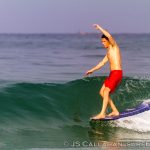Surfing Sierra Leone by Sam Bleakley
July 1st, 2014Three or four times a year I travel with an international adventure team called surfEXPLORE to find and document new surfing waves, often in post conflict or post environmental disaster locations. We’ve just returned from Sierra Leone.
From travelling to other areas of post-conflict Africa I’ve learned never to define places through their wars, or limit expectations or understandings through media representations. In Sierra Leone’s case, accounts of the generations who abandoned farming to sieve dirt in stagnant muddy waters, mining blood diamonds in the hope of a winner; child soldiers high on a deadly cocktail of cocaine and gunpowder known as brown-brown. But as nations reflect on the scars, these images can get in the way of future possibilities, stunting creative change, inviting piety and aid to places that demand ecological education – how to learn sustainability and self-sufficiency.
I went to Sierra Leone to use surfing to get under the skin of the coastline and showcase the country’s potential. Of course, water, electricity and available work are front-line issues, but the country is ambitious and on the rise. Local music is a great metaphor for Sierra Leone’s resurgence – strong, dynamic, driving and lyrical. This celebration of life is best captured in Freetown’s music heroes Ansumana Bangura, Suleiman Rogie and Abdul Tee-Jay. They gained global recognition before the civil war for fusing drumming templates and traditional songs of bravery and romance with Afrobeat guitars and calypso styles. They called it ‘palm-wine’ music, then ‘Milo-jazz’ after the empty Milo cans filled with stones that are used as rattles. Today the soundtrack to the dancefloors of Freetown (where there is a growing recording industry) is hip-hop and dancehall, using keyboards and digital mixers. But beach parties still blast out the palm-wine hits known as ‘oldies’.
The capital Freetown is hemmed in by steep hills and streams of traffic. Ragged poda poda mini taxis rule the streets, blasting the latest hits from speakers. Loudhailers encourage tax payment, while musicians wear their tax bills pinned to their jackets and sing about water shortages. Hair salons are crammed full of wigs and offer intricate cuts. The old Krio clapboard houses are coloured russet red and black. The spoken Krio, once a phonetic trading slang for freed slaves – West Indian soldiers who fought for the British against the French between 1793 and 1815, settled – has been assimilated into the local culture. Now it’s a full-blown West African language with idioms and phrases:
“Aw di bohdi?” How are you doing?
“Di bohdi wehl” Good, thanks!
Our plan was to explore the remote Turtle Islands to the south of the country. As far as we knew, we were the first to surf in this archipelago, a web of animist secret societies, surrounded by shallow shifting sandbars.
There are nine islands spread across 60 kilometres populated by approximately 1,000 people in fishing communities, specializing in net-fishing, mat-making and weaving. We quickly set up a rhythm, surfing each morning around the Turtle Islands and in the afternoon exploring surf breaks marked on our maps. Depending on the wind direction, the days were clear-blue or off-white with saturated clouds threatening rain. Atomic cumulonimbus skies rose from the mainland and at night in the distance the sky split open with lighting. Soon the rainy season would arrive like a blue-grey sponge, wringing out regularly over three months. But this was the surf season, the transition between dry and wet season, the best opportunity for long overhead waves that beat the sand like drummers, air pockets swelling the whitewater and showering me in saltspray.
I made tracks across the water, wind stripping foam from the lip as I bent the cutback to fit the curve in the wave, and then snapped back as the wave collapsed. I kicked out in an arc that allowed me to snatch the surfboard in mid-air in direct call-and–response to the wave’s collapse, land with grace and paddle out with a gaze already anticipating the coming set wave, pumped up but not inflated. Every surfer knows this song line. Chorus, solo, chorus and coda, with good drumming at its heart and grace in the glide.

